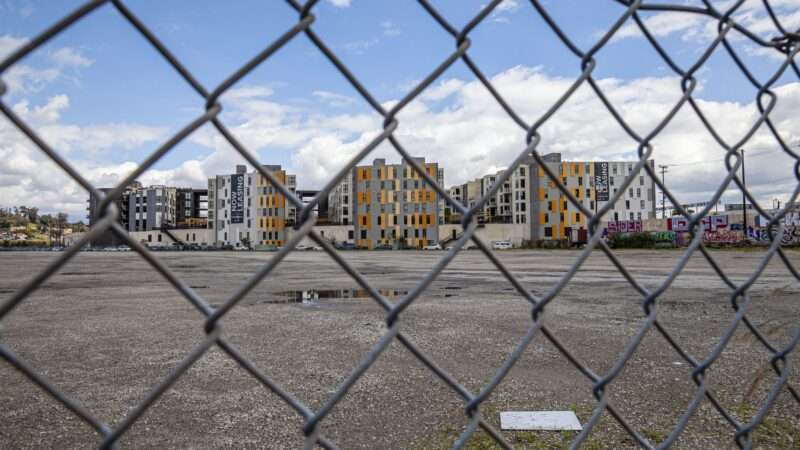
There's yet another attempt to revive California's shuttered redevelopment agencies—those crony-capitalist abominations that abused eminent domain, ran up debt without a public vote, and distorted development decisions at the local level. This year's redevelopment effort is renamed the Reconnecting Communities Redevelopment Act, but a cute new name doesn't hide redevelopment's sordid history.
It's oddly delusional even by Capitol standards to revive these tax-draining agencies when the state lacks sufficient revenues to meet its current spending. Last year, Assemblymember David Alvarez (D–Chula Vista) proposed recreating the agencies largely as they existed before Gov. Jerry Brown and the Legislature eliminated them in 2011 to help plug a gaping budget hole. It died in committee, the victim of a budget deficit estimated at around $32 billion.
Alvarez is back this year with Assembly Bill 2945 even though the current deficit is estimated at around $45 billion or higher. The state dissolved the agencies 12 years ago. Since then, lawmakers have passed measures that bring back modest portions of redevelopment—such as Infrastructure Finance Districts that use tax-increment financing to pay for limited infrastructure-related developments.
However, broader redevelopment revivals have failed—and likely will do so again. AB 2945 passed through committee but is headed toward rocky terrain. In 2019, former Gov. Brown threw shade on that year's revival effort: "A lot of people wanted to see it go, and it did free up almost $2 billion a year for schools. And if people want to bring it back they're going to take billions from the schools, and I would assume those people who care about the California public schools will fight that very hard."
Brown was spot on. As much as I'd like to think that free market arguments against redevelopment swayed lawmakers, the real bill killer came from the powerful California Teachers Association. The teachers' union clearly wouldn't ignore efforts to tap their funding sources. Sure the state backfilled those lost education dollars, but California doesn't have the spare cash to do that in the face of its remarkably large deficit.
As a refresher, California created redevelopment agencies in the 1940s to help rebuild inner-city slums. The basic redevelopment financial structure allows city governments to float bonds to pay for infrastructure related to urban-renewal projects. Cities gained the resulting increase in property taxes—called the tax increment—under the thinking that the projects spur gains in property values. That money then paid off the bonds.
By declaring an area blighted, agencies could unilaterally divert property tax revenues from traditional public services toward these privately built projects. Cities could declare virtually anything blighted (too little urbanization or too much of it, buildings with chipping paint, excessive vacant lots, insufficient tax revenue in the area, etc.) and then seek out developers to build new shopping centers or venues, or whatever is preferred in City Hall.
Traditional urban renewal projects caused their share of widely known problems, namely the obliteration of neighborhoods to make way for the above-mentioned developments. I strongly support Proposition 13, which keeps Californians from being taxed out of their homes. But after it limited tax revenues, localities came up with creative means to bolster their tax base. They learned that redevelopment could subsidize auto malls, shopping centers, and hotels that brought in additional sales taxes, so it quickly became a tax-grabbing scheme rather than an urban renewal tool.
Most noxiously, redevelopment law gave cities the power to invoke eminent domain—a property-taking power they used and abused early and often. They bulldozed neighborhoods, drove small businesses off of their land, and bullied people who lacked the resources to fight back. Often, the envisioned projects never materialized, leaving cities with vacant lots. There were some arguably successful projects, but the process worked as one would expect when the government gains unchecked power to take and redistribute property.
Redevelopment advocates claim that California needs to restore these agencies because of the housing crisis. They had set aside 20 percent of their tax increment toward affordable housing, but the state has since stepped up funding of such housing. It's a topic for another day, but because of the various union and environmental rules that come with subsidies, these projects cost far more than market-rate alternatives and haven't made a dent in the state's housing shortfalls. So adding more such spending isn't the answer.
And redevelopment exacerbated the housing crisis by teaching cities to view land-use decisions through a fiscal lens. With redevelopment, cities preferred commercial projects that brought in their sought-after sales-tax bonanza over housing developments. The best way to boost housing supply is to reduce regulations and fees—not give cities an incentive to choose big-box stores over new neighborhoods.
I know it's hard to let go of a shuttered government program, but it's time for lawmakers to move on. There's no conceivable reason to recreate these disastrous agencies.
This column was first published in The Orange County Register.
The post California Lawmakers Might Resurrect Failed 'Urban Renewal' Program appeared first on Reason.com.







